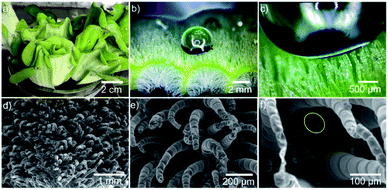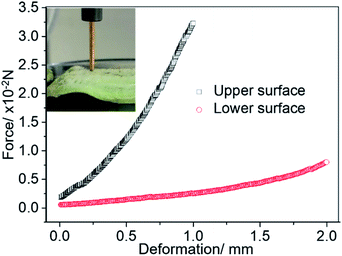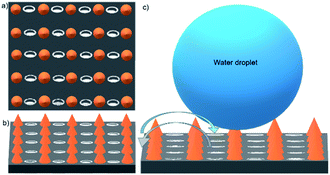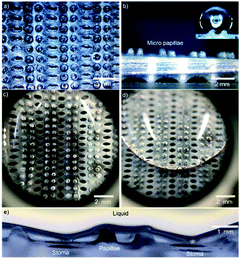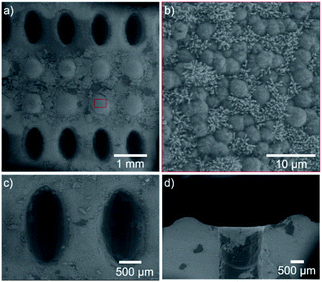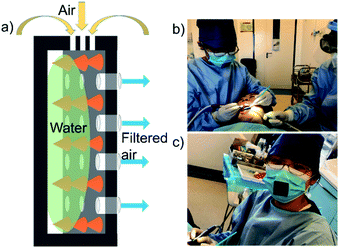 Open Access Article
Open Access ArticleCreative Commons Attribution 3.0 Unported Licence
A stomata-inspired superhydrophobic portable filter system†
Yuanping Maa,
Feng Zhaob,
Lei Wang *c,
Yuchen Dingd,
Hongbin Zhaoe,
Hao Wanga and
Jing Liu
*c,
Yuchen Dingd,
Hongbin Zhaoe,
Hao Wanga and
Jing Liu cf
cf
aDepartment of Stomatology, Beijing Tian Tan Hospital, Capital Medical University, Beijing 100070, China
bSpecialized Robot Engineering and Technological Center of Hainan Province, Hainan Vocational University of Science and Technology, Haikou 571126, China
cBeijing Key Lab of Cryo-biomedical Engineering, Key Lab of Cryogenics, Technical Institute of Physics and Chemistry, Chinese Academy of Sciences, Beijing 100190, China. E-mail: leiwang@mail.ipc.ac.cn
dDepartment of Physics and Astrophysics, Rensselaer Polytechnic Institute, Troy 12180, USA
eState Key Laboratory of Advanced Materials for Smart Sensing, General Research Institute for Nonferrous Metals, Beijing 100088, China
fDepartment of Biomedical Engineering, School of Medicine, Tsinghua University, Beijing 100084, China
First published on 25th May 2021
Abstract
Stomata, specialized functional openings distributed on the leaf surface, are used for plant respiration by allowing gas exchange, i.e., taking in carbon dioxide and releasing oxygen, and for water content regulation. Their function is vital to plant survival. Leaves with different wettability exhibit different stomata densities. In this study, we find that stomata on Pistia stratiotes L. leaves are protected by superhydrophobic setae, which prevent direct contact between the stomata and water in humid environments by suspending water droplets on the top of the setae. Thus, oxygen and carbon dioxide are freely exchanged through the stomata. This structure inspired us to design and develop a mask for filtering solid particles and noxious gas from the atmosphere. The incoming gas is in convective contact with water, achieving a filtering efficiency. The solid particles and potential harmful gas in air are wetted and captured by water, leaving fresh air for healthy breathing. This novel design has potential applications in the treatment of respiratory diseases.
A stoma is a plant gas exchange channel that is used for carbon dioxide intake and oxygen release, playing a crucial role in plant survival in nature.1–3 The distribution and density of stomata on the leaf surface may vary with surface wettability. On the hydrophilic leaves of a locust tree, the stomata density on the lower surface is higher than that on the upper surface. This unique design is beneficial for respiration and photosynthesis, even in rainy conditions. Some leaves with superhydrophobic surfaces exhibit a higher stomata density on the upper surface than that on the lower surface, because of their robust water-repellence.4–7 Rough micro-/nano-topography may allow significantly more air flow between solid–liquid interfaces with water droplets' suspension on the peak region of the rough solid surface.8–11 Thus, the superhydrophobic topography suppresses direct contact between the stomata and water, preventing contamination and yielding healthy plants.
Many plants in nature possess superhydrophobic leaves, e.g., lotus, taro, and Pistia stratiotes L.12–14 Different from other superhydrophobic plants with micro/nano-topography, Pistia stratiotes L. plants have millimetre-level superhydrophobic setae. Their high topographical features are especially beneficial for long-lasting and steady breathing in the water environment. Inspired by this natural design, we developed a novel air filtration system. It consists of stomata arrays integrated with superhydrophobic micro-papillae. The micro-hole arrays filter micro-sized solid particles from the air and provide fresh air for breathing.
Pistia stratiotes L. is a self-cleaning floating herbaceous plant that lives on the water surface. The plant's surface is covered with superhydrophobic millimeter-sized setae (mm-setae) arrays for keeping a stable respiration shown in Fig. 1a and b, enabling the plant survival in high-humidity environments. Water droplets with a large surface tension are easily suspended on the surface of setae arrays (Fig. 1c and Movie Online Resource 1†). Thus, they rarely contact the stomata under the setae arrays, maintaining a layer of flowing air at the solid–liquid interface, further enhancing the leaf survivability. Even when the leaf surface is 1 m below the water level, the leaf can survive for more than 24 h due to the amount of air retained between the mm-setae. The ability of the Pistia stratiotes L. leaf to survive underwater is better than that of the lotus leaf.5,15 In addition, solid dust may be easily captured by a water droplet, and once it is wetted, it cannot get out of the water droplet due to the large surface tension and excellent wettability of water.16–20 Fig. S1 and Movie Online Resource 2† show a captured solid particle that floats in the water droplet. In this process, water filters the air.21
The surface of the Pistia stratiotes L. leaf is composed of mm-setae and stomata. The mm-setae and stomata play two vital roles for plant survival, i.e., they provide the airflow and serve as a gateway for gas exchange, respectively. Fig. 1d–f shows the SEM micrographs of the leaf surface for better insight into topographical details. The mm-setae, with a height of ∼1 mm, are covered by nano-petals and wax material for achieving the superhydrophobic function, and the stomata are located in the root region of the mm-setae (Fig. 1f). Large setae effectively hinder direct contact between stomata and water. Droplet suspends on the top region of rough surface and shows Cassie's state.22,23 The mm-setae are distributed not only on the upper surface but also on the lower surface of the leaf (Fig. S2†), both playing a significant role in maintaining water-repellence and respiration, further enhancing the survival ability underwater.24
The mm-setae on the leaf surface exhibit excellent mechanical properties required to resist the external force exerted by water and avoid wetting. We used a micromechanical balance to test the mechanical properties of mm-setae on the upper and lower surfaces (Fig. 2). A stress of 3.2 × 10–2 N is generated when the mm-setae are bent at a deformation of 1 mm. The relationship between the deformation and the stored elastic energy (Γ) is shown in eqn (1):22
 | (1) |
Inspired by the functionality of the combination of stomata and superhydrophobic mm-setae, we designed a superhydrophobic membrane with upper surface composed of superhydrophobic micro-papillae and micro-stomata arrays (Fig. 4). The micro-papillae, with a height of 500 μm and a base diameter of 500 μm, could provide more air flow and induce a liquid droplet suspension on their tips (Fig. 4b). The contact angle of the 10 μL-droplet is larger than 152°, and the droplet quickly sheds off the surface with a tilting angle of 2°, providing a passage for air (inset in Fig. 4b). The micro-stomata are located between the micro-papillae and extend through the membrane. The long and short diameters of elliptical stomata are 1 mm and 500 μm, respectively. The space between two neighboring stomata, with a width of 500 μm, provides the superhydrophobic function and a lot of air between the solid surface and water. The stomatal channels with a length of 4 mm pass through the whole membrane (Fig. S3†). When the surface is covered by water, the micro-papillae generate small bubbles and air layer at liquid/solid interface (Fig. 4c). The three-phase contact line is very unstable, as it shrinks and detaches from the solid surface when the surface is tilted at an angle of 2° (Fig. 4d). The excellent superhydrophobic performance indues liquid droplet suspension on the tip of micro-papillae, preventing liquid from contacting with the stomata (Fig. 4e and S4†). In the magnified view of the surface shown in Fig. 5, the surface is covered by micro sphere and ZnO nano-rod, which enhances the roughness and further water-repellence function.
The designed bio-fabricated respiratory system is constructed by this membrane equipped with a polymethyl methacrylate (PMMA) shell, and it is used to capture micro-sized solid particles and gas pollutants from the atmosphere (Fig. 6). The membrane is locked in the PMMA shell as a gate to prevent the infiltration of water as shown in the Movie 3.† A filter mask is obtained after mounting the respiratory system on a mask. Fig. 7a shows its working schematic. During the breathing process, the air moves through the valley of the superhydrophobic micro-papillae after entering the respiratory system, and it is filtered by water before being transported into the breathing system (Fig. 7b). Most of solid micro particles and odorous gas once contact the water, they are wetted and absorbed by the water. As the stale gas passes through the sample, it turns into cleaner air. Practical application process by medical staff illustrate that the mask system filters not only solid dusts but also harmful gases in the air (Fig. 7c). Most of the solid particles from the air are absorbed due to their excellent water wettability (Fig. S5†). This design effectively improves respiratory system.
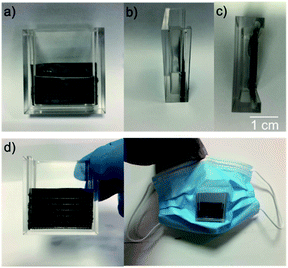 | ||
| Fig. 6 The bio-fabricated respiratory system. (a–d) Different side views of the bio-fabricated system (Movie S3†). (e) The filter system is implemented in a mask. | ||
The water in the PMMA shell could be replaced by a volatile drug to treat diseases. Drugs are transported through the stomata and enter the body by the respiratory tract. The size of stomata controls the drug flowing speed. Moreover, this system can be recycled. When the water/drug solution in the PMMA shell is dry, the shell could be reused after washing with water. The number of reuses can exceed 120 times.
In conclusion, inspired by the topography of the natural leaf surface, we developed a novel kind of air filter. The bio-fabricated surface is equipped with superhydrophobic micro-setae and perforating structural micro-stomata. Water suspends on the superhydrophobic micro-setae, providing significantly more flowing air at the valley of the micro-setae. The air is filtered when it goes through the valley and the stomata, providing fresh, comfortable, and moderately humid air for the human respiratory system. This study provides an effective fabrication method for respiratory filtration systems, having potential applications for masks, breather valves, and medical treatment.
Conflicts of interest
There are no conflicts to declare.Acknowledgements
This work is supported by the National Natural Science Foundation of China (No. 21805294). Lei Wang supervised this work. Lei Wang and Yuanping Ma performed the experiment, and wrote the manuscript, Feng Zhao, Yuchen Ding, Hongbin Zhao, Hao Wang and Jing Liu discussed the results.Notes and references
- D. Kroisova, Prog. Opt., 2012, 57, 93–132 CrossRef.
- K. M. Monja-Mio, F. B. Pool, G. H. Herrera, M. EsquedaValle and M. L. Robert, Sci. Hortic., 2015, 189, 32–40 CrossRef CAS.
- V. Fernández, et al., New insights into the properties of pubescent surfaces: peach fruit as a model, Plant Physiol., 2011, 156, 2098–2108 CrossRef PubMed.
- C. Neinhuis and W. Barthlott, Characterization and Distribution of Water-repellent, Self-cleaning Plant Surfaces, Ann. Bot., 1997, 79, 667–677 CrossRef.
- H. J. Ensikat, P. Ditsche-Kuru, C. Neinhuis and W. Barthlott, Superhydrophobicity in perfection: the outstanding properties of the lotus leaf, Beilstein J. Nanotechnol., 2011, 2, 152–161 CrossRef CAS PubMed.
- C. Lin, Y. Huang, X. Li, X. Sun, W. Zhang, J. Huang, X. Ying and M. Liu, Fabrication of superhydrophobic surfaces inspired by “stomata effect” of plant leaves via swelling-vesiculating-cracking method, Chem. Eng. J., 2020, 125935 CrossRef CAS.
- A. Gargava, C. Arya and S. R. Raghavan, Smart hydrogel-based valves inspired by the stomata in plants, ACS Appl. Mater. Interfaces, 2016, 8, 18430–18438 CrossRef CAS PubMed.
- S. Wang and L. Jiang, Definition of superhydrophobic states, Adv. Mater., 2007, 19, 3423–3424 CrossRef CAS.
- K. R. Murphy, W. T. McClintic, K. C. Lester, C. P. Collier and J. B. Boreyko, Dynamic defrosting on scalable superhydropbic surfaces, ACS Appl. Mater. Interfaces, 2017, 9, 24308–24317 CrossRef CAS PubMed.
- L. Wang, M. Wen, M. Zhang, L. Jiang and Y. Zheng, Icephobic gummed-tape with nano-cones on microspheres, J. Mater. Chem. A, 2014, 2, 3312–3316 RSC.
- C. Hao, Y. Liu, X. Chen, J. Li, M. Zhang, Y. Zhao and Z. Wang, Bioinspired Interfacial Materials with Enhanced Drop Mobility: From Fundamentals to Multifunctional Applications, Small, 2016, 12, 1825–1839 CrossRef CAS PubMed.
- M. Liu, S. Wang and L. Jiang, Nature-inspired superwettability systems, Nat. Rev. Mater., 2017, 2, 17036 CrossRef CAS.
- E. Celia, T. Darmanin, E. T. D. Givenchy, S. Amigoni and F. Guittard, Recent advances in designing superhydrophobic surfaces, J. Colloid Interface Sci., 2013, 402, 1–18 CrossRef CAS PubMed.
- Z. Guo and W. Liu, Biomimic from the superhydrophobic plant leaves in nature: Binary structure and unitary structure, Plant Sci., 2007, 172, 1103–1112 CrossRef CAS.
- J. Zhang, X. Sheng and L. Jiang, The dewetting properties of lotus leaves, Langmuir, 2009, 25, 1371–1376 CrossRef CAS PubMed.
- B. Bhushan and Y. C. Jung, Biomimetics inspired surfaces for superhydrophobicity, self-cleaning, low adhesion, and drag reduction, Nanotribology and Nanomechanics II, 2011, pp. 533–699 Search PubMed.
- L. Feng, S. Li, Y. Li, L. Zhang, J. Zhai, Y. Song, B. Liu, L. Jiang and D. Zhu, Super-hydrophobic surfaces: from natural to artifical, Adv. Mater., 2002, 14, 1857–1860 CrossRef CAS.
- A. Marmur, The lotus effect: superhydrophobicity and metastability, Langmuir, 2004, 20, 3517–3519 CrossRef CAS PubMed.
- P. Li, L. Wang, S. Tang, Y. Xing, H. Zhao and J. Liu, Shape control of lotus leaf induced by surface submillimeter texture, Adv. Mater. Interfaces, 2020, 2000040 CrossRef.
- Y. Su, B. Ji, K. Zhang, H. Gao, Y. Huang and K. Hwang, Nano to micro structural hierarchy is crucial for stable superhydrophobic and water-repellent surfaces, Langmuir, 2010, 26, 4984–4989 CrossRef CAS PubMed.
- R. Chen, Y. Wan, W. Wu, C. Yang, J. He, J. Cheng, R. Jetter, F. K. Ko and Y. Chen, A lotus effect-inspired flexible and breathable membrane with hierarchical electrospinning micro/nanofibers and ZnO nanowires, Mater. Des., 2019, 162, 246–248 CrossRef CAS.
- A. B. D. Cassie and S. Baxter, Wettability of porous surfaces, Trans. Faraday Soc., 1944, 40, 546–551 RSC.
- A. J. B. Milne and A. Amirfazli, The Cassie equation: How it is meant to be used, Adv. Colloid Interface Sci., 2012, 170, 48–55 CrossRef CAS PubMed.
- R. Poetes, K. Holtzmann, K. Franze and U. Steiner, Metastable underwater superhydrophobicity, Phys. Rev. Lett., 2010, 105, 166104 CrossRef PubMed.
- A. Otten and S. Herminghaus, How plants keep dry: A physicist's point of view, Langmuir, 2004, 20, 2405–2408 CrossRef CAS PubMed.
Footnote |
| † Electronic supplementary information (ESI) available. See DOI: 10.1039/d1ra03297f |
| This journal is © The Royal Society of Chemistry 2021 |

